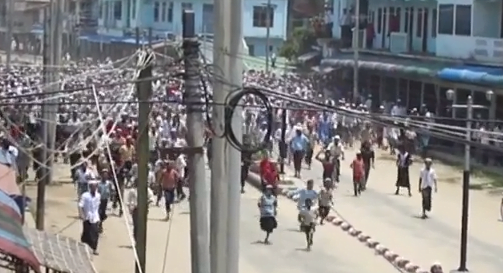Human Rights Watch released a devastating report uncovering how Myanmar government forces collaborated with a local ethnic group to persecute ethnic Rohingya muslims during riots last month. The catalyst of the riots was the rape of a local girl by Rohingya men. That set off weeks of ethnic violence, but rather than trying to quell this violence, the Human Rights Watch report alleges that government foces sided with local ethnic Arakan groups against the Rohingyas.
Here’s one snippet from the report:
A Rohingya man in Sittwe, 36, told Human Rights Watch that an Arakan mob “started torching the houses. When the people tried to put out the fires, the paramilitary shot at us. And the group beat people with big sticks.” Another Rohingya man from the same neighborhood said, “I was just a few feet away. I was on the road. I saw them shoot at least six people – one woman, two children, and three men. The police took their bodies away.”
In Sittwe, where the population was about half Arakan and half Muslim, most Muslims have fled the city or were forcibly relocated, raising questions about whether the government will respect their right to return home. Human Rights Watch found the center of the once diverse capital now largely segregated and devoid of Muslims.
In northern Arakan State, the army, police, Nasaka border guard forces, and Lon Thein paramilitaries have committed killings, mass arrests, and other abuses against Rohingya. They have operated in concert with local Arakan residents to loot food stocks and valuables from Rohingya homes. Nasaka and soldiers have fired upon crowds of Rohingya villagers as they attempted to escape the violence, leaving many dead and wounded.
This video explains the situation well.
A Human Rights Watch researcher makes this key point:
“If the atrocities in Arakan had happened before the government’s reform process started, the international reaction would have been swift and strong,” said Adams. “But the international community appears to be blinded by a romantic narrative of sweeping change in Burma, signing new trade deals and lifting sanctions even while the abuses continue.”
In fact, the World Bank announced just today it is prepared to resume assistance to Myanmar after 25 years to the tune of $85 million in grants for development and the clearing of almost $400 million in arrears from old loans.
Myanmar has been undergoing a period of rapid political transformation for the past several months. Aung San Suu Kyi’s liberation from house arrest and her entry to electoral politics is the most visible sign of this transformation. But as she and others have warned, Myanmar is not out the woods yet.
This report shows that the Burmese government believes it can re-enter the good graces of the international community while still committing human rights abuses on a mass scale. To date, the international community has not done much to dissuade them of this notion.
